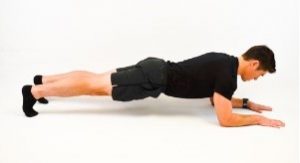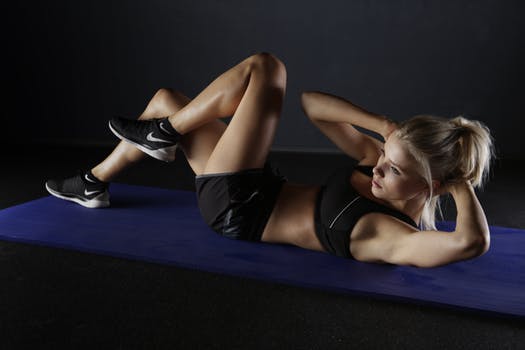 In pursuit of the perfect stomach the exercise of choice for the majority of people is the sit up. Years of poor advice and articles written in many health magazines have only served to reinforce the importance of this inherently flawed exercise. I am pleased to say that this is changing and people are starting to opt for complete ‘core’ workouts as opposed to the muscle isolation exercises of the past. The simple truth of the matter is that everybody has ‘abs’, the question is how much body tissue is layered on top of them! It should also be understood that is impossible to lose weight from only one part of your body. With these two pieces of information it becomes obvious that holding up one exercise as the ‘Holy Grail’ is flawed. Resistance training is important to increase muscle tone boost your basal metabolic rate, which is the rate at which you burn off calories at rest, however, without combining that with a good cardiovascular workout and decreasing your total calorie intake, you will never reach your goals.
In pursuit of the perfect stomach the exercise of choice for the majority of people is the sit up. Years of poor advice and articles written in many health magazines have only served to reinforce the importance of this inherently flawed exercise. I am pleased to say that this is changing and people are starting to opt for complete ‘core’ workouts as opposed to the muscle isolation exercises of the past. The simple truth of the matter is that everybody has ‘abs’, the question is how much body tissue is layered on top of them! It should also be understood that is impossible to lose weight from only one part of your body. With these two pieces of information it becomes obvious that holding up one exercise as the ‘Holy Grail’ is flawed. Resistance training is important to increase muscle tone boost your basal metabolic rate, which is the rate at which you burn off calories at rest, however, without combining that with a good cardiovascular workout and decreasing your total calorie intake, you will never reach your goals.
 This brings me onto the second aspect of this article. Not only will conventional sit ups not get you the defined stomach you want, they will actually weaken your back, potentially causing you serious problems in the future. Research on the subject has been carried out by Professor McGill, a world authority on spinal injuries and the performance training of athletes. McGill has shown that a sit up produces 730 lbs of compression through the spine which is enough to cause microscopic weakening of the discs and the surrounding supportive musculature and ligaments. The common thing that we hear in the clinic is ‘I just bent down to pick….up off the floor’. Now in most cases the object being picked up is usually light weight, certainly not enough to cause damage to a healthy back. Only last week a new patient came to see me who had bent down to put a piece of paper under a door and his back went into spasm. It is inconceivable that a healthy back should suffer in this way if it is in fact healthy. What the majority of the people have not been told is that your back has a certain capacity to function well, if you reduce this capacity by sitting with a bad posture, lifting objects from your back and not your hips and knees, performing flexion motions of the spine e.g. sit ups etc then you fatigue the supportive structures and make it vulnerable to injury, even from fairly innocuous tasks.
This brings me onto the second aspect of this article. Not only will conventional sit ups not get you the defined stomach you want, they will actually weaken your back, potentially causing you serious problems in the future. Research on the subject has been carried out by Professor McGill, a world authority on spinal injuries and the performance training of athletes. McGill has shown that a sit up produces 730 lbs of compression through the spine which is enough to cause microscopic weakening of the discs and the surrounding supportive musculature and ligaments. The common thing that we hear in the clinic is ‘I just bent down to pick….up off the floor’. Now in most cases the object being picked up is usually light weight, certainly not enough to cause damage to a healthy back. Only last week a new patient came to see me who had bent down to put a piece of paper under a door and his back went into spasm. It is inconceivable that a healthy back should suffer in this way if it is in fact healthy. What the majority of the people have not been told is that your back has a certain capacity to function well, if you reduce this capacity by sitting with a bad posture, lifting objects from your back and not your hips and knees, performing flexion motions of the spine e.g. sit ups etc then you fatigue the supportive structures and make it vulnerable to injury, even from fairly innocuous tasks.
 So now we have established that sit ups are not a good idea, what is the answer? I have mentioned it in the first paragraph but collectively they are called core stability exercises and the plank is a good example of this. The idea of core stability exercises is that you activate your entire abdominal muscles at the same time as recruiting the low back muscles. This process is akin to having your own back support that you can activate at will, which will not only help to prevent injury on a day to day basis but also enhance sports performance. The process of activating your core correctly is difficult to explain in an article like this but in essence you should feel your abdominal muscles tighten and slightly push out, as if you were preparing yourself for being pushed backwards or sideways. This is in contrast to the commonly taught method of ‘sucking your stomach in towards your spine’ which does not activate all of the abdominal muscles. It is a process that can be difficult to master and it is important that you are taught by someone who truly understands how this is done. If you would like a better visual understanding of what I am talking about click the link HERE and take a look at the video I recorded a couple of months ago.
So now we have established that sit ups are not a good idea, what is the answer? I have mentioned it in the first paragraph but collectively they are called core stability exercises and the plank is a good example of this. The idea of core stability exercises is that you activate your entire abdominal muscles at the same time as recruiting the low back muscles. This process is akin to having your own back support that you can activate at will, which will not only help to prevent injury on a day to day basis but also enhance sports performance. The process of activating your core correctly is difficult to explain in an article like this but in essence you should feel your abdominal muscles tighten and slightly push out, as if you were preparing yourself for being pushed backwards or sideways. This is in contrast to the commonly taught method of ‘sucking your stomach in towards your spine’ which does not activate all of the abdominal muscles. It is a process that can be difficult to master and it is important that you are taught by someone who truly understands how this is done. If you would like a better visual understanding of what I am talking about click the link HERE and take a look at the video I recorded a couple of months ago.
Regardless of the type of injury our patients have suffered, at the right time in the treatment plan we will always teach them core stability exercises as this is the best way of strengthening the body for the future. The wording I have used there is very important, ‘at the right time’. How can you possibly fully strengthen a spine or any joint for that matter, if it is inherently dysfunctional because of poor biomechanics? It is akin to the old story of the person who built their house on the sand, it is doomed to fail. That is why we will initially work to restore function to the body and then work to stabilise it with the core exercises. This is fundamental because our goal is not just to get patients out of pain but to increase the function of their body for their long term health.

